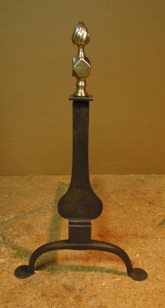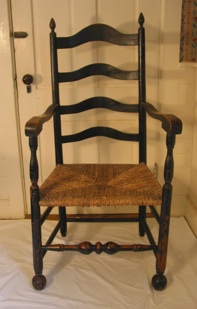The story of 45 years of restoration work - From Winterthur to Maine

I bought my first Windsor chair at a country sale near Wilmington, Delaware in 1960, at the age of ten. Four years later, I unwittingly began my career when I got a job in a large model-making shop that was mainly engaged in museum work. I had the good fortune at age fifteen to go to work for the first director of the Winterthur Museum, Charles F. Montgomery, a brilliant man who worked with H.F. duPont to form his extraordinary collection and home into the preeminent museum of American decorative arts. Among all the mundane work I did were interspersed intriguing jobs like polishing his collection of pewter and cleaning pieces of furniture that have since become icons of American art. I think that he was both impressed by my obsessive interest in these things and my lack of knowledge about them. He kindly took an interest in my education and spent a great deal of time teaching me at the museum in the hours after school; I had no idea at the time that it was anything other than normal to walk through Winterthur with Charles Montgomery discussing the subtle differences between North Shore and Boston Federal furniture, the grace of an arm carved by William Savery, and the exuberant nature of late eighteenth century country Connecticut furniture. I was sent to work with other people at Winterthur: cleaning brasses with a delightful Scotsman, mostly just observing the painting restorer, and performing tasks under the direction of Arthur Van Reuth, the chief cabinetmaker. I loved everything about shop work: having the chance to handle and examine the best furniture, the smell of turpentine and wood, and watching the easy skill of this elderly man who could turn a flawless finial in a several minutes. The first things that I worked on in Mr. Van Reuth’s home shop was one of the incredible bentwood chairs made by Samuel Gragg, and which he patented as the “elastic chair” in 1808.
When I was seventeen Mr. Montgomery arranged for me to work for the summer on the floor at David Stockwell’s, an antique shop carrying one of the finest inventories in the marketplace of the 1960s. It was a wonderful opportunity to spend my days peering under the best furniture and turning things around to see what usually remains out-of-sight. I also got to see enough of the business to know that as much as I loved this stuff, I didn’t want spend a life as a dealer.
The night I graduated from high school I went to Nantucket. Fresh from my job with Stockwell, I stopped into the only antique shop in town and asked for a job on the floor. Instead, the owner, Frank Sylvia, hired me to assist the shop’s in-house cabinetmaker, Louis Carroll, who was an extraordinary craftsman. There was little glamor to my days, often spent with a broom or scraper in my hand, or endlessly pushing a new drawer back and forth over a bed of ultra-fine sand and wax to give it the look of long use. However, observing a master at work day after day is excellent training for a young person with an impressionable mind. Shop practices, movements, and tricks of the trade become familiar.
In the autumn of 1969, at age eighteen, I opened my first shop in Wilmington, and began taking in furniture for restoration and the occasional orders for new reproduction furniture. Wilmington in those days was full of serious collectors, a paradise for a young restorer. I was able to work on remarkable things, and I had an appetite to learn how to do it all. I was given the chance to work on one fabulous and exciting thing after another, so I was able to learn by doing and build up a treasure trove of experience in those early days.
I opened my Ellsworth, Maine shop in 1988, where I have continued my work, and have increasingly become aware (and grateful) that the learning process continues without pause. It would seem that with more than fifty years of experience, all would have been revealed, but nothing could be further from the truth. I am glad and excited by new work that comes into the shop, and I look forward to the opportunity to refine old practices and to learn something along the way. When I look back over the years I realize that I have been incredibly fortunate to have had a hand in preserving so many beautiful objects. I feel that I have lived in golden days, right from the beginning of my career.
Note: The photograph on the left above shows a cherry tilt top stand with an extraordinary elm burl top, its block is chestnut; it required extensive structural repair to the legs. Next is one of a pair of knife blade andirons from a pair formerly owned by H.F. duPont; after the removal of rust the iron surfaces were re-patinated, and the finials were cleaned and polished. The appearance of the 1720-30 Pennsylvania armchair on the right was improved considerably with a thorough cleaning and consolidation of the deteriorated finish on the ball feet.
Copyright © David Williams Restoration ❖ All rights reserved
207 667 4591


